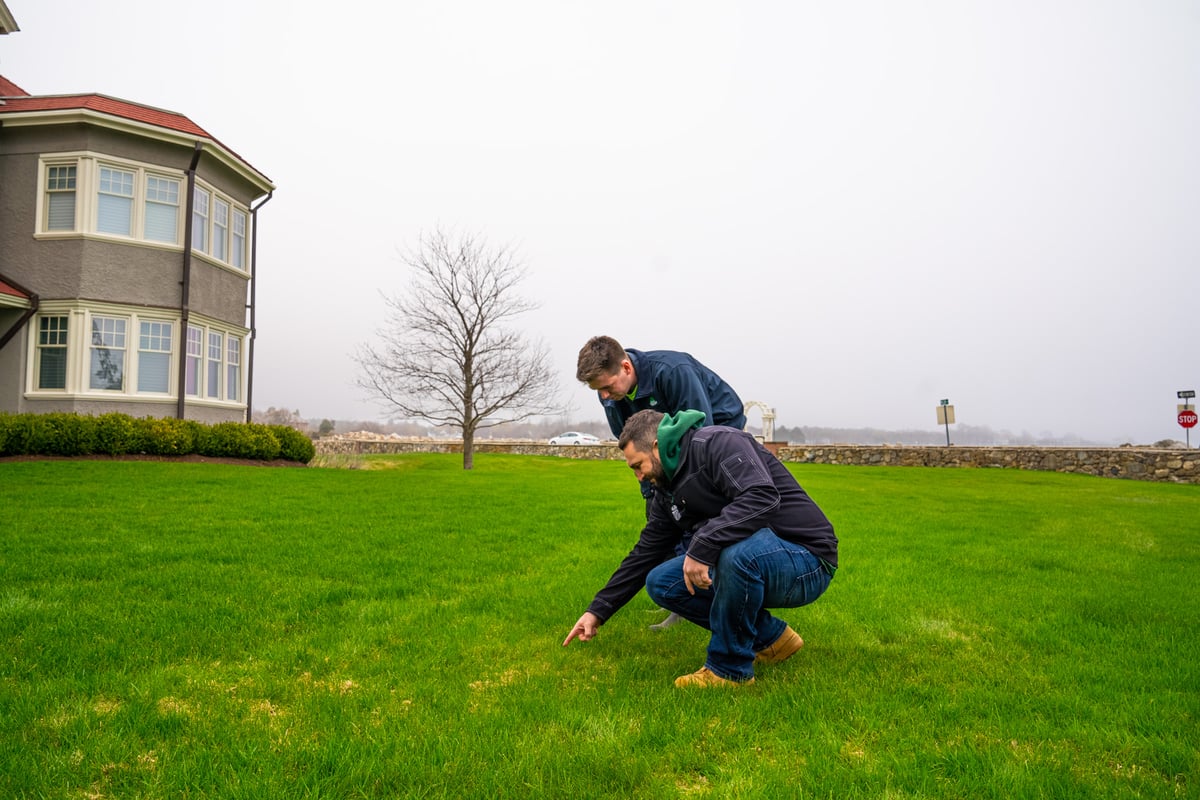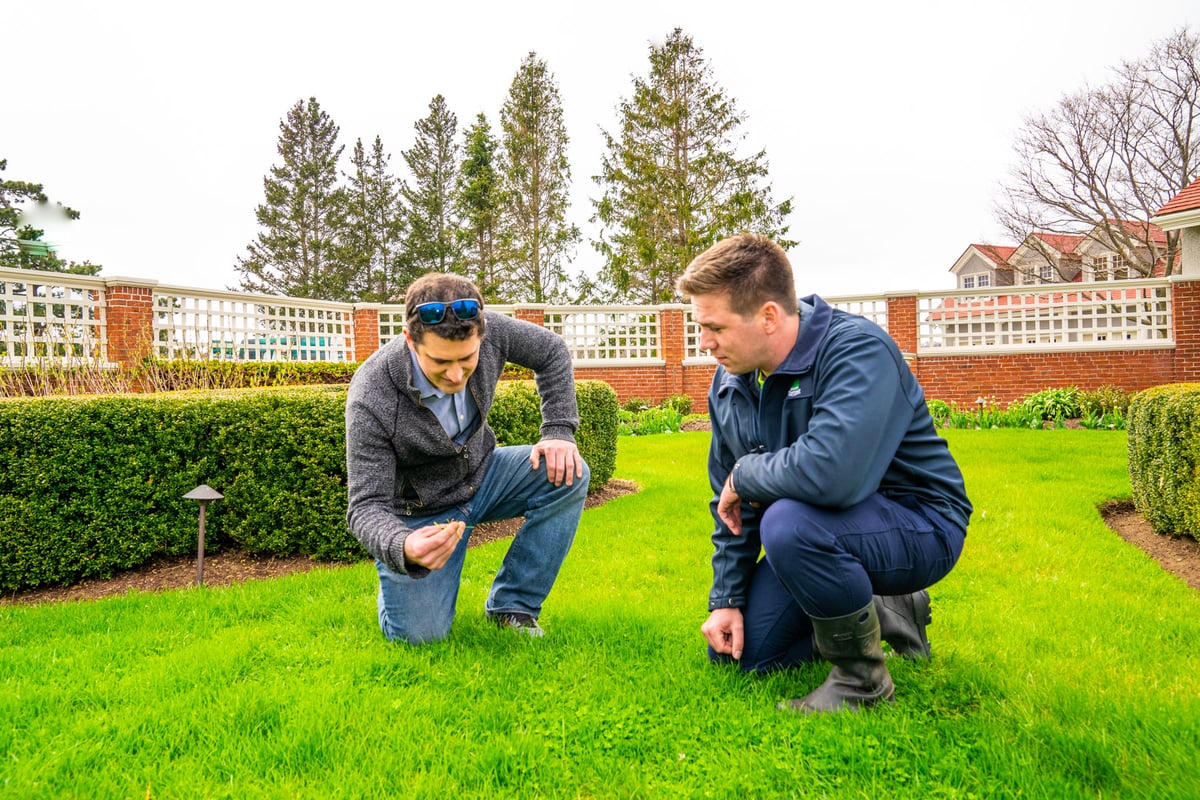
Brown Patch Fungus: How to Identify & Treat This Lawn Disease
You’ve probably already realized that your lawn has a lot of enemies. Whether it’s lawn weeds, pests, or even just harsh weather conditions, your turf has to put up with a lot of stressors on a daily basis.
That list also includes lawn diseases. Just like people can get sick, so can your lawn.
Lawn disease can be a major source of frustration as it can spread rapidly and potentially harm large areas of turf. This is why it’s important to always be on the lookout for signs of trouble and also have a good understanding of what you might be dealing with.
In this article, we’ll dive into everything you should know about brown patch grass fungus. This is one of the most common lawn fungi in New England.
What is Brown Patch Fungus?
Brown patch lawn disease (also sometimes referred to as “large patch disease”) is a fungal infection caused by the moisture-loving fungus Rhizoctonia Solani. It commonly affects all cool-season grasses but it has been known to be particularly harmful to perennial ryegrass and tall fescue lawns.

This disease most commonly occurs in the middle and latter parts of the summer, when the temperature is hot and the weather is humid. These are the optimal conditions for this fungus to grow and spread.
What Causes Brown Patch Fungus?
Brown patch is caused by Rhizoctonia Solani, a fungus that lives in hot, humid conditions. But in order to fully understand what causes Brown Patch fungus, you must first understand the lawn disease triangle.

Any lawn disease is ultimately the result of three factors:
- The disease-causing organism (in this case, Rhizoctonia Solani)
- A susceptible host (a grass species in which this organism is likely to be present)
- A favorable environment (in this case, moist, hot weather)
If all three of these factors align, the probability of dealing with a disease is high…even if you’ve been doing “all the right things” for your lawn.
This is one of the reasons why lawn disease is so frustrating. It is something that simply may be out of your control.
What Does Brown Patch Fungus Look Like?
As you might have guessed, brown patch is named for its appearance. This disease shows up as brown patches in the lawn. These patches start as small areas of brown grass but they can spread rapidly. Small brown patches can start to grow together.

Keep in mind that just because you have brown spots on your lawn does not mean you definitely have Brown Patch lawn disease. Brown spots can also show up due to pest problems and even environmental stressors (like drought).
This is why it’s so important to understand what you’re dealing with as different problems will have different solutions.
How to Get Rid of Brown Patch Fungus on Your Lawn
As far as how to treat brown patch fungus, a fungicide is the best course of action for serious cases.
Not all lawn disease situations require treatment. A minor case of fungus might actually clear up on its own. However, if you have a rapidly spreading case of brown patch lawn fungus, then fungicides will help stop the spread.
In severe cases, you might require multiple brown patch fungus treatment applications.

It’s important to note that fungicides won’t cure already-affected grass. A common misconception is that fungicides cure disease. In reality, they just stop the fungus from spreading further into the lawn. This is a valuable intervention for bad cases of disease.
Infected areas that have already been impacted and do not bounce back may require repairs like aeration and overseeding to fill in bare spots.
How to Prevent Brown Patch Lawn Fungus
As we mentioned, you can do all the right things for your lawn and it could still end up with a disease. Sometimes if the conditions are right for fungus to start growing, there’s not much you can do.
That being said, you can implement good cultural practices that at least help mitigate your risk and ensure that your lawn fares better overall.
In general, a healthier lawn is going to fare better against lawn disease than a lawn that is already struggling. This is where those good cultural habits come into play.
For instance, because lawn fungus thrives in wet conditions, you would want to avoid excessive watering. Proper fertilization is also important. You don’t want to over- or under-fertilize as it could impact lawn fungus growth.
Good lawn mowing habits are also important. When you cut your lawn too short, you actually put it under a lot of stress. When this occurs, a lawn disease has a better chance of spreading.
In summary, keeping your lawn thick and healthy will help prevent lawn disease from taking over. With proper fertilization, watering, and mowing, you can take steps toward promoting healthier turf.
Choosing Lawn Care in Southern New Hampshire, Northeastern Massachusetts, & Southern Maine
It helps to have a lawn care expert on your side when it comes to dealing with lawn diseases like brown patch grass fungus. A lawn care pro can diagnose what’s going on and help you determine the best course of action.
Spotting lawn disease early on is always helpful. This is why lawn disease inspections are included in all of our lawn care packages at Seacoast Turf Care. Having a lawn care professional on your property regularly will ensure they are able to inspect for early signs of trouble.
At Seacoast Turf Care, we want to be your partner in success. We know that a healthy lawn is important to you and we want to help. We provide lawn care services in Southern NH, Northeastern Massachusetts, and Southern Maine.
Lawns can be a lot of work, but you don’t have to take care of yours alone. We’re here to help.
Want to learn more about what makes us a great choice for your lawn care needs? At Seacoast Turf Care, we service NH towns near Stratham, North Hampton, Exeter and many more. Get lawn care pricing for your Southern NH, Southern Maine, or Northeastern Massachusetts property.
Image Source: brown patch lawn disease



